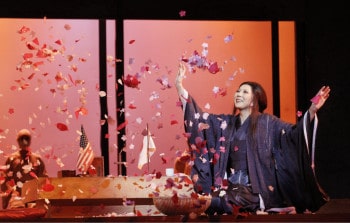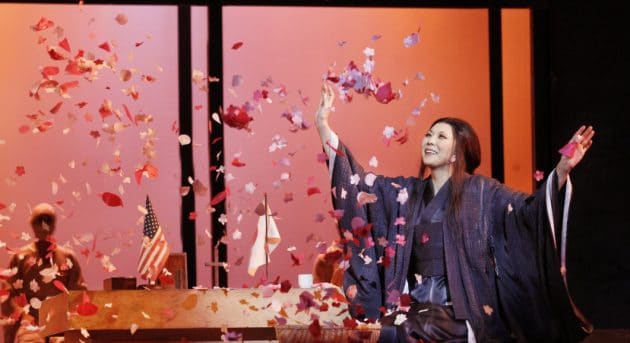Review: Madama Butterfly, Opera Australia return season
Madama Butterfly, in this production by director Moffatt Oxenbould, is not a newcomer to Opera Australia – it debuted in 1997. Seeing it in the 2015 summer season with fresh, first-viewing eyes, it was clear to see that whatever spark that led it to be such a big hit, and kept it on high rotation in OA programming, has quietly died out.
The production settles on a level that’s certainly not unpleasant, but it’s not exciting, and it stays there, gently and flatly in place, through the whole opera. The music itself doesn’t settle; Gianluca Martinenghi directs his orchestra into soaring love rushes and heartbreakingly impassioned despair, but on stage, there’s not a lot of life to be found.

One of the most enduring stories in the literary canon, and originally from an 1898 story, Madama Butterfly has also been told through works like M. Butterfly and Miss Saigon. US Lieutenant Pinkerton (a comfortable James Egglestone) marries Cio-Cio-San, Madama Butterfly (Alexia Voulgaridou), and although he’s enraptured by her, it’s not a ‘real’ marriage; he always intends to go home to America and be married for real. Basically, it’s a real great way to feel good about having sex with a teenager while he’s in Japan.
He leaves, and Cio-Cio-San is alone for three years, desperately believing Pinkerton will return. A tiny American flag sits on stage, pathetically small and so tragic – she believes in the liberating promise of her husband’s country, and has adopted it for herself – and her devoted servant Suzuki (Sian Pendry) doesn’t really buy into this husband returning myth, but Cio-Cio-San can’t be swayed. Her Lieutenant loves her.
Of course, it doesn’t end well.
But honestly, this production is worrying from the beginning. Puccini’s gorgeously transformative score aside, this staging manages to buy into the culturally imperalist text by making any Japanese character on stage overly exoticised and infantilised. Their staging is drawn from Kabuki tradition, and the servants have bound faces and blank clothing, but all this particular, heightened direction really does is tell us that there’s no common ground between Japanese and American people, which is hardly helpful, particularly in 2015.
The only Japanese character that feels like a real person is Suzuki, and she’s a servant, never able to be equal with the American men on stage. Works are as they were written, and the story shouldn’t be struck from memory or anything so extreme, but nothing major has to be changed to right this, either; directing women and characters of colour to share equal audience engagement and sympathy as the white men onstage immediately would present a more inclusive production.
Voulgaridou’s Butterfly rises to sharply impressing heights with the arias to end all arias, Un bel di, but her acting is broad at best and wooden at worst; it’s very hard to take her seriously, or feel for her in any meaningful way. She never really feels like a person. She’s a doll of all the men, really, the ones who denounce her and the ones that abandon her and the ones who pity her (and sometimes do more than one of these things) and that really shouldn’t be the case. She’s a romantic, a loyalist; why doesn’t that come through in OA’s production? It’s worrying. It’s also uncomfortable to watch Greek and Australian women play the Japanese lead female roles.
Pendry and Voulgaridou are the vocal standouts on stage, but Michael Honeyman’s Consul Sharpless is a real pleasure. He has an accommodating ease in his presence, and a laidback delivery in his voice that is never fully divorced from its authority, which only reminds you how much authority he actually has.
The set is very, very pretty, in the box that Peter England and Russell Cohen have designed; it opens up to reveal the stars for the lovers, and later for Cio-Cio-San as she drifts on that memory; it is moored in water, gently lapping; it feels light and expansive and important, this box of a home. Floral imagery is strong, and elegant. If it weren’t for the faceless servants making the set feel more clinical than calm, it would be a tremendous success.
It’s a beautiful looking opera and it’s a beautifully sung opera, but without any real way to invest in the story, pretty as it looks, this impassioned, compelling old story just feels restrained and polite – and love won and lost isn’t even remotely polite.




